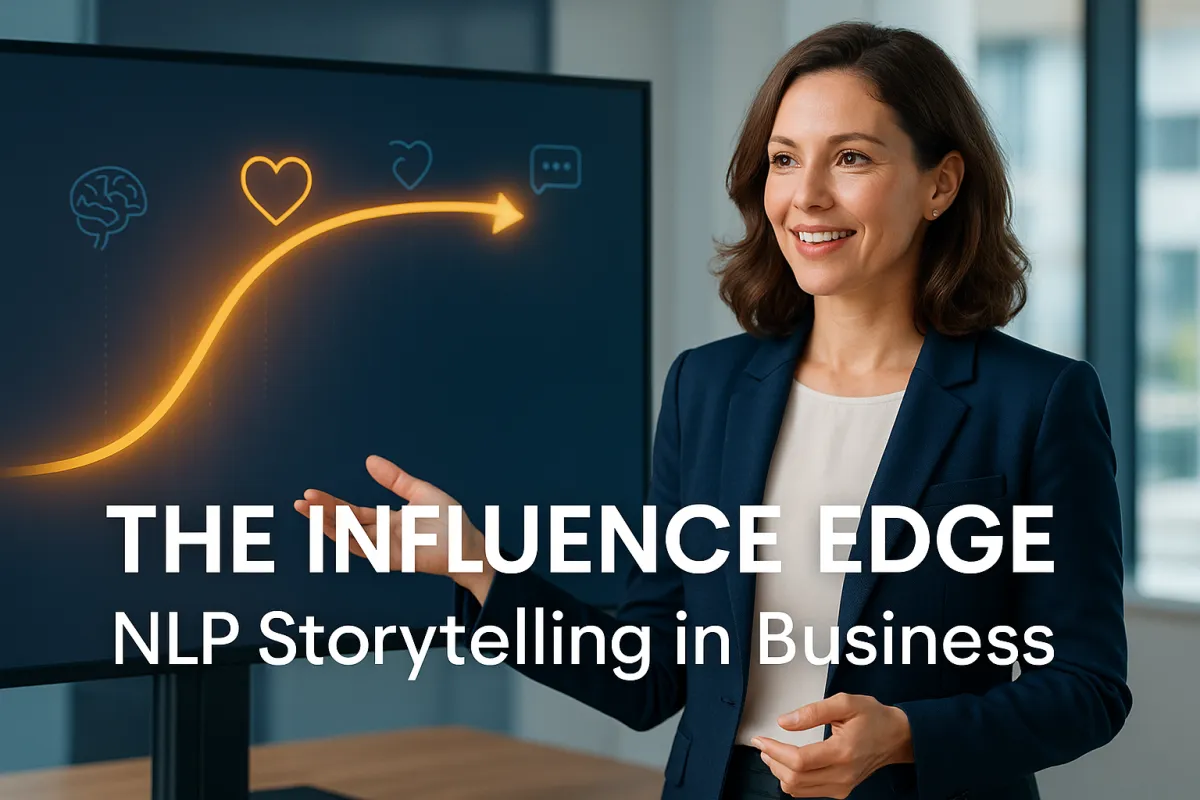
The Influence Edge: NLP Storytelling in Business
The Influence Edge: NLP Storytelling in Business
How to Influence, Connect, and Convert Through Strategic Communication
By Mariana Dalto
Welcome to The Influence Edge, where we explore how to communicate with impact, lead with clarity, and influence with intention. In this article—based on my solo podcast episode—we’re diving deep into the world of storytelling through the lens of Neuro-Linguistic Programming (NLP).
If you’re a coach, consultant, entrepreneur, or service provider, this is for you. Mastering NLP storytelling can help you close more deals, earn trust faster, and communicate more authentically.
1. What is NLP, and Why Should You Care?
Neuro-Linguistic Programming (NLP) is a powerful psychological framework that examines how our thoughts (neuro), language (linguistic), and behavior patterns (programming) influence our actions and results.
In business and sales, NLP is more than just theory—it’s a toolkit for influence. It helps you understand how people process information and how to adjust your communication to match their internal language. The result? You speak their language and increase the chances of connection and action.
🔹 NLP helps you:
Build rapport faster
Tailor your message to the client’s thinking style (visual, auditory, kinesthetic)
Shift objections into opportunities
Inspire emotional buy-in
Present solutions with greater clarity and confidence
It’s the difference between talking at your audience and connecting with them.
2. Why Storytelling is Game-Changer in Marketing and Sales
People don’t remember facts—they remember stories.
Storytelling activates the brain, evokes emotions, and makes your message memorable.
As my mentor Kane Minkus emphasizes, storytelling is most powerful at the beginning of a client interaction. When done well, it builds instant trust, shows credibility, and creates a deeper level of engagement. People are more likely to buy from someone who understands their journey—and stories are the fastest way to demonstrate that.
Storytelling also:
Breaks through information overload
Makes abstract concepts concrete
Evokes emotions that drive decisions
Creates personal and brand loyalty
Business isn’t just transactional. It’s emotional. Stories tap into that.
3. NLP Storytelling Techniques to Elevate Your Influence
Here are 7 NLP-based storytelling techniques you can start using today:
1. Sensory-Rich Language
Describe sights, sounds, and feelings to create immersive experiences.
Instead of saying “I launched a campaign,” say “I launched a bold, fast-paced campaign that turned heads within hours.”
2. Emotional Triggers
Great stories tap into emotions: relief, excitement, trust, fear, hope.
Ask yourself: What do I want the listener to feel?
3. Metaphors
Metaphors simplify the complex.
A marketing funnel could be explained as “an invisible staircase guiding your audience from curiosity to commitment.”
4. Anchoring Positive Emotions
Use key phrases or visual cues repeatedly to anchor optimism, success, or trust.
5. Reframing
Shift how a problem is seen.
Instead of “This is a big risk,” try “This is a high-leverage opportunity.”
6. Client Success Stories
Use real examples to show transformation. Let your clients’ journey become your best sales pitch.
7. Charisma Amplifiers
NLP teaches that charisma is a learned skill, not just a personality trait. Use:
Vocal variety
Facial expressions
Body language
To boost the magnetic quality of your storytelling.
4. When to Use Stories in Your Business
Strategic storytelling should be woven throughout your business conversations:
Initial Engagement
Start with a story that mirrors the client’s journey. This builds immediate rapport.Deepening the Relationship
Use stories to show that you understand their pain points and have walked a similar path.Objection Handling
When clients hesitate due to price or fear, share a story about someone who felt the same—but moved forward and succeeded.Sales Conversations
Pair your pitch with a compelling narrative. Don’t just tell them what you do—show it through the eyes of someone you've helped.
5. Tips to Craft a Powerful Business Story
Every great story has a beginning, middle, and end. Here’s a simple NLP-friendly framework:
🔹 Beginning
Set the stage. Describe the problem or starting point.
🔹 Middle
Share the emotional or physical struggle. Build tension. What did they try? What challenges came up?
🔹 End
Provide the resolution. What changed? What results were achieved?
💡 Pro Tip: Define your story’s intent before you start. Do you want to inspire confidence, shift a mindset, or overcome hesitation?
6. NLP Tips to Deepen your Influence in Sales
To deepen your NLP influence toolkit, consider these additional techniques inspired by certified NLP practitioners:
✅ Active Listening: Listen beyond the words. Tune in to tone, pauses, and unsaid concerns.
✅ Mirroring: Match body language or tone to build subconscious trust.
✅ Positive Language: Instead of “not a bad option,” say “a strong, value-driven choice.”
✅ Representational Systems: Visual thinkers like “seeing the big picture,” while kinesthetic types prefer “feeling it out.” Adapt your language accordingly.
✅ Meta-Model Questions: Ask open-ended questions that invite details.
→ Instead of “Is this working?” ask “What part of this is working best for you?”
7. Boosting Your Charisma with NLP
There are 4 core domains of charisma that enhance your influence:
Expressive Infusion
Use dynamic body language, facial expressions, and voice to deliver impact.Tension & Release
Keep your audience hooked by building anticipation and delivering “aha” moments.Emotional Appeal
Be real. Vulnerability and sincerity draw people in.Intentional Metaphors
Metaphors are sticky. They give people something to remember and relate to.
By mastering these, your communication becomes more magnetic, persuasive, and influential.
8. Inspire Action Through Authenticity
At the end of the day, storytelling isn’t manipulation—it’s connection. It’s how you earn attention, respect, and loyalty in a world of constant noise.
If you’re a service provider who wants to elevate your sales conversations, marketing content, and leadership presence—then NLP storytelling is a must-have skill in your business arsenal.
🎧Prefer to listen instead?
👉Click here to listen to this episode on The Mariana Dalto Show
